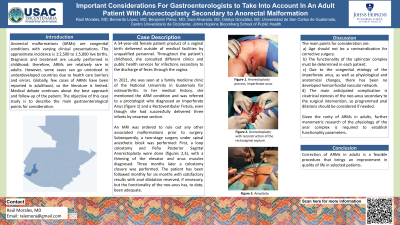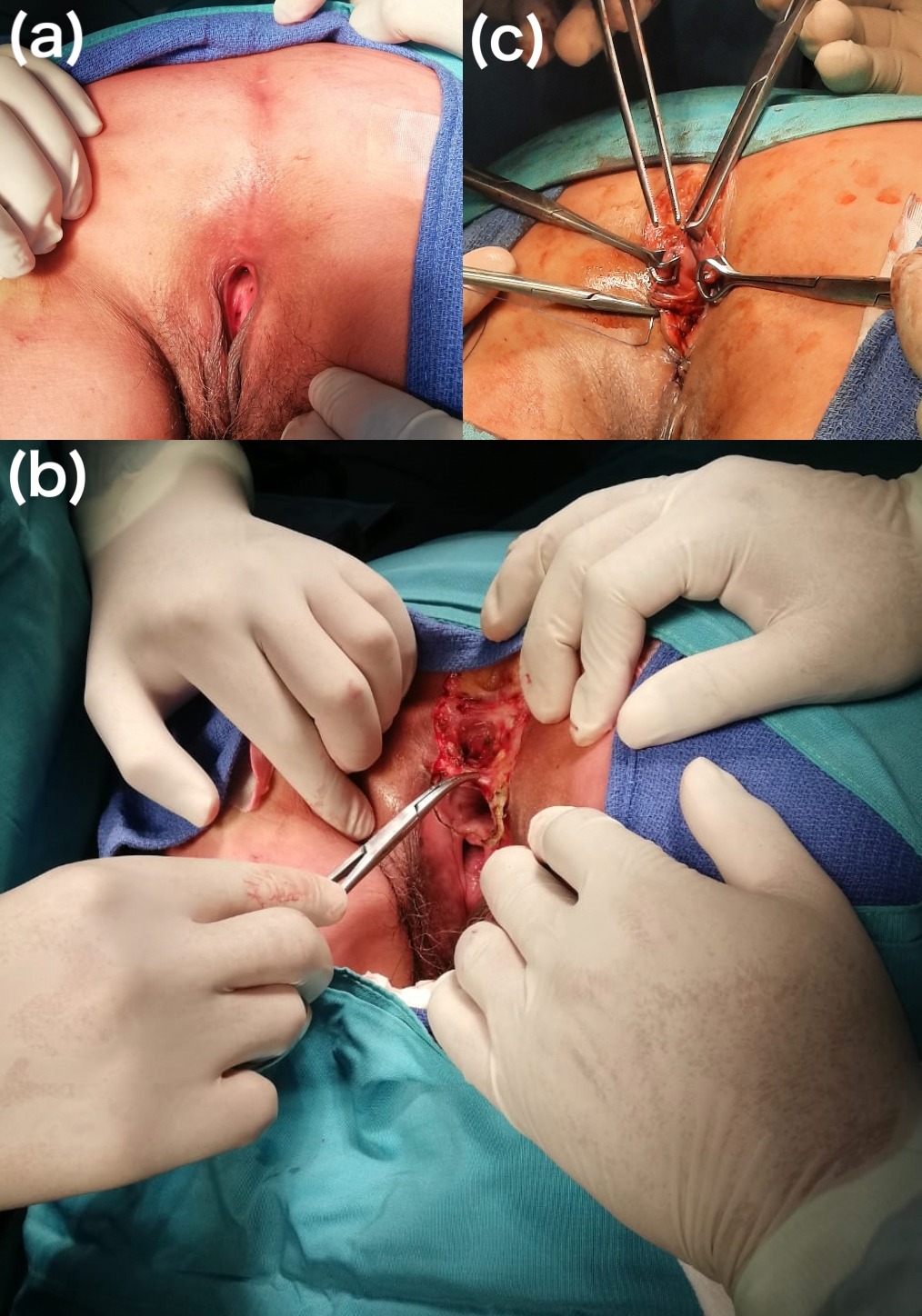Back


Poster Session D - Tuesday Morning
Category: Colon
D0131 - Important Considerations for Gastroenterologists to Take into Account in an Adult Patient With Anorectoplasty Secondary to Anorectal Malformation
Tuesday, October 25, 2022
10:00 AM – 12:00 PM ET
Location: Crown Ballroom

Has Audio

Bernardo D. Lopez Samayoa, MD
Johns Hopkins Bloomberg School of Public Health
Baltimore, MD
Presenting Author(s)
Raúl A. Morales López, MD1, Bernardo D. Lopez Samayoa, MD2, Benjamin Pérez Pérez, MD3, Sara M. Alvarado González, BS4, Odalys R. González Coj, BS4
1Centro Universitario de Occidente, Universidad de San Carlos de Guatemala / Universidad Nacional Autónoma de México, Quetzaltenango, Quetzaltenango, Guatemala; 2Johns Hopkins Bloomberg School of Public Health, Baltimore, MD; 3Centro Universitario de Occidente, Universidad de San Carlos de Guatemala / Centro Medico Los Altos, Quetzaltenango, Quetzaltenango, Guatemala; 4Centro Universitario de Occidente, Universidad de San Carlos de Guatemala, Quetzaltenango, Quetzaltenango, Guatemala
Introduction: Anorectal malformations (ARMs) are congenital conditions with varying clinical presentations. The approximate incidence is 1:2,500 to 1:5,000 live births. Diagnosis and treatment are usually performed in childhood; therefore, ARMs are relatively rare in adults. However, some cases can go unnoticed in underdeveloped countries due to health care barriers and errors.
Globally, few cases of ARMs have been reported in adulthood, so the literature is limited. Medical debate continues about the best approach and follow-up of the patient. The objective of this case is to describe the main gastroenterological points for consideration.
Case Description/Methods: A 54-year-old female patient product of a vaginal birth delivered outside of medical facilities by unqualified personnel. Throughout the patient's childhood, she consulted different clinics and public health services for infections secondary to the discharge of feces through the vagina. In 2021, she was seen at a family medicine clinic of the national university in Guatemala for osteoarthritis. In her medical history, she mentioned the ARM condition and was referred to a proctologist who diagnosed an Imperforate Anus (a) and a Rectovestibular Fistula, even though she had successfully delivered three infants by c-section.
An MRI was ordered to rule out any other associated malformations prior to surgery. Subsequently, a two-stage surgery under spinal anesthetic block was performed: First, a loop colostomy and Peña Posterior Sagittal Anorectoplasty were done (b, c), with a thinning of the elevator and anus muscles diagnosed. Three months later a colostomy closure was performed. The patient has been followed monthly for six months with satisfactory results with anal dilatation reserved, if necessary, but the functionality of the neo-anus has, to date, been adequate.
Discussion: The main points for consideration are a) age should not be a contraindication for corrective surgery; b) the functionality of the sphincter complex must be determined in each patient; c) due to the congenital etiology of the imperforate anus, as well as physiological and the anatomical changes, there has been no developed hemorrhoidal vascular network; d) the main anticipated complication is cicatricial stenosis of the neo-anus secondary to the surgical intervention, so programmed anal dilations should be considered if needed. Given the rarity of ARMs in adults, further manometric research of the physiology of the anal complex is required to establish functionality parameters.

Disclosures:
Raúl A. Morales López, MD1, Bernardo D. Lopez Samayoa, MD2, Benjamin Pérez Pérez, MD3, Sara M. Alvarado González, BS4, Odalys R. González Coj, BS4. D0131 - Important Considerations for Gastroenterologists to Take into Account in an Adult Patient With Anorectoplasty Secondary to Anorectal Malformation, ACG 2022 Annual Scientific Meeting Abstracts. Charlotte, NC: American College of Gastroenterology.
1Centro Universitario de Occidente, Universidad de San Carlos de Guatemala / Universidad Nacional Autónoma de México, Quetzaltenango, Quetzaltenango, Guatemala; 2Johns Hopkins Bloomberg School of Public Health, Baltimore, MD; 3Centro Universitario de Occidente, Universidad de San Carlos de Guatemala / Centro Medico Los Altos, Quetzaltenango, Quetzaltenango, Guatemala; 4Centro Universitario de Occidente, Universidad de San Carlos de Guatemala, Quetzaltenango, Quetzaltenango, Guatemala
Introduction: Anorectal malformations (ARMs) are congenital conditions with varying clinical presentations. The approximate incidence is 1:2,500 to 1:5,000 live births. Diagnosis and treatment are usually performed in childhood; therefore, ARMs are relatively rare in adults. However, some cases can go unnoticed in underdeveloped countries due to health care barriers and errors.
Globally, few cases of ARMs have been reported in adulthood, so the literature is limited. Medical debate continues about the best approach and follow-up of the patient. The objective of this case is to describe the main gastroenterological points for consideration.
Case Description/Methods: A 54-year-old female patient product of a vaginal birth delivered outside of medical facilities by unqualified personnel. Throughout the patient's childhood, she consulted different clinics and public health services for infections secondary to the discharge of feces through the vagina. In 2021, she was seen at a family medicine clinic of the national university in Guatemala for osteoarthritis. In her medical history, she mentioned the ARM condition and was referred to a proctologist who diagnosed an Imperforate Anus (a) and a Rectovestibular Fistula, even though she had successfully delivered three infants by c-section.
An MRI was ordered to rule out any other associated malformations prior to surgery. Subsequently, a two-stage surgery under spinal anesthetic block was performed: First, a loop colostomy and Peña Posterior Sagittal Anorectoplasty were done (b, c), with a thinning of the elevator and anus muscles diagnosed. Three months later a colostomy closure was performed. The patient has been followed monthly for six months with satisfactory results with anal dilatation reserved, if necessary, but the functionality of the neo-anus has, to date, been adequate.
Discussion: The main points for consideration are a) age should not be a contraindication for corrective surgery; b) the functionality of the sphincter complex must be determined in each patient; c) due to the congenital etiology of the imperforate anus, as well as physiological and the anatomical changes, there has been no developed hemorrhoidal vascular network; d) the main anticipated complication is cicatricial stenosis of the neo-anus secondary to the surgical intervention, so programmed anal dilations should be considered if needed. Given the rarity of ARMs in adults, further manometric research of the physiology of the anal complex is required to establish functionality parameters.

Figure: Anorectoplasty Process: (a) Imperforate anus, (b) Anorectoplasty with reconstruction of the rectovaginal septum, (c) Anoplasty.
Disclosures:
Raúl Morales López indicated no relevant financial relationships.
Bernardo Lopez Samayoa indicated no relevant financial relationships.
Benjamin Pérez Pérez indicated no relevant financial relationships.
Sara Alvarado González indicated no relevant financial relationships.
Odalys González Coj indicated no relevant financial relationships.
Raúl A. Morales López, MD1, Bernardo D. Lopez Samayoa, MD2, Benjamin Pérez Pérez, MD3, Sara M. Alvarado González, BS4, Odalys R. González Coj, BS4. D0131 - Important Considerations for Gastroenterologists to Take into Account in an Adult Patient With Anorectoplasty Secondary to Anorectal Malformation, ACG 2022 Annual Scientific Meeting Abstracts. Charlotte, NC: American College of Gastroenterology.
